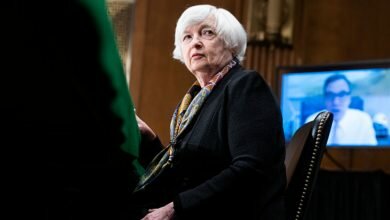Why Phoenix—of all places—is the fastest growing home value in America

For 33 months now, Phoenix, Arizona, has led the rise in home prices. In the last year alone, the cost of the median house in the area has risen by a third. Over the course of two years, it’s up 57%, with rental prices coming down. Unfortunately for locals, wages in the area haven’t been on the same high-speed elevators, rising only 5.3% in 2021. According to a study conducted by Arizona economist Elliot Pollack, the median home value in the area has risen 216% since 2000. , while the average salary has increased by only 48%. Pollack estimates that by 2025, only a third of the region’s population will be able to afford a home.
Read more: The economy is great. middle class is madu
At first, the demand for homes in Phoenix seems difficult to explain. It remains uncomfortably hot for several months a year. Its food culture remains unheard of. It doesn’t have sexy employers like Amazon or Nike, nor is it a hub of high-paying industries like finance or tech. As a mid-century city, it is not a place rich in historical buildings or prestigious cultural institutions. For many years the defining feature of life in Phoenix – other than the dry summer – has been its affordability.
Clearly, some of the same forces are at play out there everywhere: Millennials, the oldest generation alive now, have reached the age where they want to buy a home. They are competing with retirees that the so-called Valley of the Sun has long attracted. Local builders are facing the same supply chain shock that has slowed the pace of new home construction everywhere. And the pandemic has added to it all, with remote workers looking for somewhere to live that is affordable and spacious.
Read more: return to the office? Not in this housing market
But there are some forces that are unique to the Phoenix. TIME talked to locals to investigate why they think the city is named after a bird that burns up unintentionally and has become so expensive—and how it feels to be exposed to fire. is close.
realtor
Experts say that a healthy housing market is one that has enough homes for sale that if no new ones hit the market, it will take four to six months for the supply to run out. Phoenix has had enough for less than a month. You think those who have sold homes for a living will have a good day. you will be wrong “It’s not a joke. I don’t like this market as a realtor,” says Nicole Lorig, who has been a licensed realtor in the area for five years. Rising prices attracted increased interest from institutional investors It has seen local first home buyers walk out of all-cash offers with incentives for sellers—like being able to stay in the home for a few more months for free—that an individual buyer can’t match.
“As a buyer’s agent, it’s hard to compete with a cash buyer,” says Lorig. “It’s definitely more viable if you’re a listing agent because you’re all waiting for offers, but there’s a lot of phone calls to answer. So it’s been difficult for everyone.”
Lorig also works in rentals, and that market is slogging up even more. “You hear stories of many people trying to rent because of a $600 to $800 increase or because their landlord has decided they want to sell,” she says. “So they have to find something new and they find that collecting rent alone is just humiliating.”
He took an elderly couple whose rented house had been sold. He qualified for a lot of homebuyer assistance, but he is in a wheelchair and needs a place close to his medical appointments. Even after their story was picked up by a local TV show and they started a GoFundMe, they couldn’t get enough money together to buy a house. In the end, he negotiated with his new landlords for a slight increase in rent in exchange for some other concessions. For some time. “It’s going to buy us some time to find a new home for them that they won’t have to move again,” says Lorig.
buyer
Dirk Larsen moved with his wife and two children from the Pacific Northwest about eight years ago. He decided to stop buying a place to make sure the move was permanent. The house they’re renting now is selling for more than double what the owners paid for seven years ago, and the family has been looking for a place to buy for six months. They have made several single day offers that were higher than the asking price and still thousands of dollars short. Larson is extremely disappointed. “People are paying a lot more than these houses,” he says. “For someone like us, who wants to buy a home and or have a small American dream – makes it impossible.”
Larson isn’t a first time home buyer. He sold his old house to move southwest, looking for the sun and a little more room to breathe. They weren’t alone. The Phoenix metropolitan area has been one of America’s fastest growing areas for many years, growing by nearly 20% in a decade. But recently this growth has been faster; By some estimates, in 2020, 291 people moved to Maricopa County per day. One reason they moved there – so they may have a yard and some space in a city where more than two-thirds of homes are single-family dwellings – is also one of the reasons it is facing such housing shortages. Is.
As its population has grown in the same decade, the number of residential units has increased by only 11%. So families like the Larsons, who say they’ll move anywhere within a 25-mile area up and down the Phoenix Valley, are facing a lack of options. “I have a pretty solid quality job and I’m feeding my family and I’m making decent money and we’re taking root here,” says Larsen. “I don’t want to be forced out. There are a lot of people who feel they are being forced out.”
business professor
According to Mark Stapp, professor of real estate at Arizona State University’s business school, you can look at the current state of Phoenix all the way back to the Great Recession. A lot of investors in Phoenix lost a lot of money during the 2008 crash, and although Arizona is a non-judicial foreclosure state—meaning landlords don’t have to go to court to evict non-paying renters – so the sector recovered quite rapidly, investors, lenders and builders were intimidated and money was left behind. “We spent five years under-building,” he says.
At the same time, the crash prompted the city to make a concerted effort to diversify its economy, and it had some success. Taiwan Semiconductor Manufacturing Company is building a very large factory there. According to a report by the Greater Phoenix Chamber Foundation, the number of transportation jobs has increased by 88% over the past 10 years, and the number of technical and scientific jobs has increased by almost 50%.
“Metro Phoenix has an incredible amount of industrial and advanced manufacturing, distribution, warehousing space, more than at any time in its history,” says Stapp. That infrastructure comes with jobs, but it wastes resources. “All those things consume concrete, steel and other materials that are shared by home construction—both apartments and single families—so there’s a competition for those scarce resources.”
Stapp says that when the pandemic hit, supplies slowed even further. “All you had to do was pump the brakes [on construction] For six or eight months and it caused a few years of tremors,” he says. “It’s like traffic on the freeway. Suddenly a person brakes as it starts to back up. So that matters.” The pandemic’s stay-at-home measures also brought new workers to Phoenix, who were looking for a larger environment and lower costs. “We used to have this relationship between the employment population and housing,” Stapp says. “Working out of nowhere has now been taken apart.” Since many of them were coming from California, where prices have also skyrocketed, they had more cash to spend on housing.
industry analyst
For Tina Tambor, who analyzes real estate data for investors for The Cromford Report, this real estate market is nothing new. “We’ve seen many perfect storms,” she says. “It’s really not unusual for us. Prices might not be that high, but we’ve been through bidding wars similar to these wars in 2012.” players”, Tambor says there are three main types of investors who are driving demand in Phoenix and harassing locals by offering higher prices, incentives for sellers, and all-cash deals.
There are so-called i-buyers—businesses like Offerpad or Opendoor—that buy homes without a seller not facing any hassle of display or listing, and then have to resell. There are both private equity and public funds, such as invitation homes, that buy and rent homes, and there are also home buyers for tourists. “It’s your Airbnb and your VRBO type of investor,” Tambor says. “Those houses have actually completely run out of supplies, not available for anyone to live in, available only to tourists. This magnifies everything in the surrounding areas as well. ,
A local realtor, Rob Olson, says he can’t see how local buyers can compete. “Of the last two homes I’ve sold, one was to a hedge fund and one was to a large rental company,” he says. “They came with cash. When you’re paying cash, you have to provide proof of funds—I’m getting proof of funds with $20 million dollars in that fund.”
Tambor is not a fan of Wall Street types. “Personally, I don’t care about corporate ownership of housing. I don’t care about Wall Street hedge funds owning residential homes. What if they buy all of our inventory?” Plus, she worries that bankers don’t have enough skin in the game. “Whenever Wall Street gets involved in investment housing, things get risky,” she says, “because Wall Street has its own Doesn’t cost money.”
worker
Alison Cook Davis, associate director of research at the Morrison Institute for the Public, says while the general push and pull of supply and demand and the amplifying effects of the pandemic are affecting many places, Phoenix’s single-family-home obsession exacerbates its situation. Used to be. Policy. “It takes too much time to build one house at a time,” she says. They estimate that Phoenix needs about 250,000 new homes to solve the housing crisis. “To do this, we would really need to shift our concentration to a higher density habitat, which would allow us to build more units in less time.”
Phoenix has exclusionary zoning laws that make it difficult for developers to build multifamily homes in as many areas. But, says Cook-Davis, who co-authored the institute’s recently released report, That’s not the only obstacle holding back affordable home construction in the state. “The Private Property Rights Protection Act, which appears to be somewhat unique to Arizona, is a voter-passed initiative that basically says that municipalities are unable to make any changes to land use policy that would adversely affect property valuations. Will make an impact,” she says.
The act, which was passed in 2006, has affected local governments that want to change their zoning rules to encourage condensation. “It’s a law that’s very well known to developers in that they have to get a community buy-in before they can make any changes, especially for things like density,” says Cook Davis.
A decade and a half later, that law could contribute to the poor supply of housing in a historically more affordable city that has implications beyond its original intentions. Cook-Davis, who is also researching the rental market, says that renters are reporting not only consistently dire financial conditions for leases, but also barriers that go beyond money. “The rental market is so tight, landlords can be so picky,” she says. “Some individuals also talked about feeling like they were being asked really personal questions and things that would never have happened on an application before.”
Must-read stories from TIME




